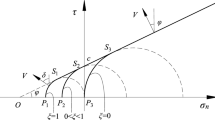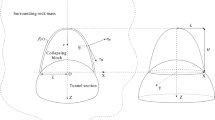Abstract
In this work, with reference to the nonlinear Mohr–Coulomb failure criterion and upper bound theorem of limit analysis, two-dimensional (2D) collapse mechanism of deep buried rectangular tunnel in layered soil mass is established with consideration of varying water tables and excess pore water pressure. The present results are compared with existing research primarily, and the agreement shows that the method is valid. Numerical analyses are conducted to investigate the influences of corresponding parameters on the potential collapse surfaces. Subsequently, a probabilistic model is performed by consolidating collapse mechanism into responses surface method (RSM). The initial cohesion and tensile strength are regarded as random variables while the remaining parameters are considered as nonrandom variables due to their lower variations or specifics for special projects. The impacts of individual nonrandom variables and cross correlations of random variables on the failure chances are studied. Then, reliability analysis is displayed to evaluate the influences of different distribution types of random variables on the tunnel stability, various cases are also designed to discuss the most unfavorable layer combination, eventually, a reliability-based design is provided to evaluate target support pressure to the tunnel roof according to the different coefficients of variation of random variables. In short, the global behaviors can be caught by means of deterministic and probabilistic analysis and which certainly facilitates to assess the stability of tunnel roof.









Similar content being viewed by others
Data availability
Some or all data, models, or code that support the findings of this study are available from the corresponding author upon reasonable request.
References
Alagha ASN, Chapman DN (2019) Numerical modelling of tunnel face stability in homogeneous and layered soft ground. Tunn Undergr Space Technol 94:103096
Anagnostou G (2012) The contribution of horizontal arching to tunnel face stability. Geotechnik 35(1):34–44
Anagnostou G, Kovári K (1996) Face stability conditions with earth-pressure-balanced shields. Tunn Undergr Space Technol 11(2):165–173
Berthoz N, Branque D, Subrin D, Wong H, Humbert E (2012) Face failure in homogeneous and stratified soft ground: Theoretical and experimental approaches on 1g EPBS reduced scale model. Tunn Undergr Space Technol 30:25–37
Chen RP, Tang LJ, Ling DS, Chen YM (2011) Face stability analysis of shallow shield tunnels in dry sandy ground using the discrete element method. Comput Geotech 38(2):187–195
Chen RP, Li J, Kong LG, Tang LJ (2013) Experimental study on face instability of shield tunnel in sand. Tunn Undergr Space Technol 33:12–21
Cherubini C (2011) Reliability evaluation of shallow foundation bearing capacity on and soils. Can Geotech J 37(1):264–269
Fellin W, King J, Kirsch A, Oberguggenberger M (2010) Uncertainty modelling and sensitivity analysis of tunnel face stability. Struct Saf 32(6):402–410
Fraldi M, Guarracino F (2009) Limit analysis of collapse mechanisms in cavities and tunnels according to the Hoek-Brown failure criterion. Int J Rock Mech Min Sci 46(4):665–673
Fraldi M, Guarracino F (2010) Analytical solutions for collapse mechanisms in tunnels with arbitrary cross sections. Int J Solids Struct 47(2):216–223
Huang F, Yang XL (2011) Upper bound limit analysis of collapse shape for circular tunnel subjected to pore pressure based on the Hoek-Brown failure criterion. Tunn Undergr Space Technol 26(5):614–618
Ibrahim E, Soubra AH, Mollon G, Raphael W, Dias D, Reda A (2015) Three-dimensional face stability analysis of pressurized tunnels driven in a multilayered purely frictional medium. Tunn Undergr Space Technol 49:18–34
Idinger G, Aklik P, Wu W, Borja RI (2011) Centrifuge model test on the face stability of shallow tunnel. Acta Geotech 6(2):105–117
Li TZ, Yang XL (2018) Probabilistic stability analysis of subway tunnels combining multiple failure mechanisms and response surface method. Int J Geomech 18(12):04018167
Li DQ, Jiang SH, Chen YF, Zhou CB (2014) Reliability analysis of serviceability performance for an underground cavern using a non-intrusive stochastic method. Environ Earth Sci 71(3):1169–1182
Low BK, Tang WH (1997) Efficient reliability evaluation using spreadsheet. J Eng Mech 123(7):749–752
Low Bk, Tang WH (2004) Reliability analysis using object-oriented constrained optimization. Struct Saf 26(1):69–89
Lü Q, Low BK (2011) Probabilistic analysis of underground rock excavations using response surface method and SORM. Comput Geotech 38(8):1008–1021
Lü Q, Sun HY, Low BK (2011) Reliability analysis of ground–support interaction in circular tunnels using the response surface method. Int J Rock Mech Min Sci 48(8):1329–1343
Lü XL, Zhou YC, Huang MS, Zeng S (2018) Experimental study of the face stability of shield tunnel in sands under seepage condition. Tunn Undergr Space Technol 74:195–205
Mollon G, Dias D, Soubra AH (2009a) Probabilistic analysis and design of circular tunnels against face stability. Int J Geomech 9(6):237–249
Mollon G, Dias D, Soubra AH (2009b) Probabilistic analysis of circular tunnels in homogeneous soil using response surface methodology. J Geotech Geoenvironmental Eng 135(9):1314–1325
Mollon G, Dias D, Soubra AH (2010) Face stability analysis of circular tunnels driven by a pressurized shield. J Geotech Geoenvironmental Eng 136(1):215–229
Mollon G, Phoon KK, Dias D, Soubra AH (2011) Validation of a new 2D failure mechanism for the stability analysis of a pressurized tunnel face in a spatially varying sand. J Eng Mech 137(1):8–21
Pan QJ, Dias D (2017) Upper-bound analysis on the face stability of a non-circular tunnel. Tunn Undergr Space Technol 62:96–102
Qin CB, Chian SC, Yang XL, Du DC (2015) 2D and 3D limit analysis of progressive collapse mechanism for deep-buried tunnels under the condition of varying water table. Int J Rock Mech Min Sci 80:255–264
Saada Z, Maghous S, Garnier D (2012) Stability analysis of rock slopes subjected to seepage forces using the modified Hoek-Brown criterion. Int J Rock Mech Min Sci 55:45–54
Soranzo E, Wu W, Tamagnini R (2015) Face stability of shallow tunnels in partially saturated soil: centrifuge testing and numerical analysis. Géotechnique 65(6):454–467
Sterpi D, Cividini A (2004) A physical and numerical investigation on the stability of shallow tunnels in strain softening media. Rock Mech Rock Eng 37(4):277–298
Viratjandr C, Michalowski RL (2006) Limit analysis of submerged slopes subjected to water drawdown. Can Geotech J 43(8):802–814
Wang HT, Wang LG, Li SC, Wang Q, Liu P, Li XJ (2019) Roof collapse mechanisms for a shallow tunnel in two-layer rock strata incorporating the influence of groundwater. Eng Fail Anal 98:215–227
Yang XL, Huang F (2013) Three-dimensional failure mechanism of a rectangular cavity in a Hoek-Brown rock medium. Int J Rock Mech Min Sci 61:189–195
Yang XL, Yin JH (2006) Estimation of seismic passive earth pressures with nonlinear failure criterion. Eng Struct 28(3):342–348
Yang XL, Zhou T, Li WT (2017) Reliability analysis of tunnel roof in layered Hoek-Brown rock masses. Comput Geotech 104:302–309
Yu L, Lü C, Wang MN, Xu TY (2019) Three-dimensional upper bound limit analysis of a deep soil-tunnel subjected to pore pressure based on the nonlinear Mohr-Coulomb criterion. Comput Geotech 112:293–301
Zhang ZX, Hu XY, Scott KD (2011) A discrete numerical approach for modeling face stability in slurry shield tunnelling in soft soils. Comput Geotech 38(1):94–104
Zhao LH, Hu SH, Yang XP, Huang F, Zuo S (2019) Limit variation analysis of shallow rectangular tunnels collapsing with double-layer rock mass based on a three-dimensional failure mechanism. J Cent South Univ 26(7):1794–1806
Zheng XK, Yang ZB, Wang S, Chen YF, Hu R, Zhao XJ, Wu XL, Yang XL (2021) Evaluation of hydrogeological impact of tunnel engineering in a karst aquifer by coupled discrete-continuum numerical simulations. J Hydrol 597:125765
Acknowledgements
We thank the editor and the reviewers for their valuable comments that improved this manuscript.
Funding
This work is financially supported by the National Nature Science Foundation of China (NSFC through grant no. 41672260).
Author information
Authors and Affiliations
Corresponding author
Ethics declarations
Conflict of interest
The authors declare no competing interests.
Additional information
Responsible Editor: Zeynal Abiddin Erguler
Rights and permissions
About this article
Cite this article
Lei, D., Xie, L., Wang, J. et al. Probabilistic stability analysis of tunnel roof in two-layer soil mass combining upper bound theorem and response surface method. Arab J Geosci 15, 1201 (2022). https://doi.org/10.1007/s12517-022-10346-5
Received:
Accepted:
Published:
DOI: https://doi.org/10.1007/s12517-022-10346-5




